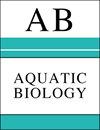巴西东南部大西洋沿岸森林溪流中甲鲶鱼Neoplecostomus microps的生殖生物学
IF 0.8
4区 生物学
Q3 MARINE & FRESHWATER BIOLOGY
引用次数: 1
摘要
摘要本文旨在分析一种名为Neoplecostomus microps (Steindachner, 1877)的鲶鱼的生殖特性,这是一种在生态学研究中很少被关注的物种。我们描述了该物种的生殖行为,并比较了2个不同盆地中发现的模式。年内,在Macae河收集的标本(117只雄性和102只雌性)没有出现性别比例的偏差。在最长的种类中,雄性占主导地位,比雌性早熟。两性的长-重关系均表现为正异速生长。性腺指数的变化和成熟阶段的频率表明,生殖期为4 ~ 6个月,从9月开始,11月达到高峰。平均绝对生殖力为43.83 (SD = 7.62)个卵母细胞,范围为32 ~ 55个。成熟卵巢卵母细胞直径频率分布为3窝,提示为分批产卵。长时间的繁殖周期,低繁殖力,大的卵,可能的亲代照顾,以及重复的产卵记录表明,N. microps的策略是最大限度地提高亲代适应性。种群结构和繁殖特征趋于平衡。猕猴河种群中雌性的早熟可能有利于种群中幼鱼的快速更替,作为对种群在雨季经历的不稳定环境条件的反应。本文章由计算机程序翻译,如有差异,请以英文原文为准。
Reproductive biology of the armored catfish Neoplecostomus microps in a coastal Atlantic Forest stream, southeastern Brazil
This work aims to analyze reproductive attributes of the species Neoplecostomus microps (Steindachner, 1877), a well-known species of the catfish family Loricariidae but little con -
templated in ecological studies. We describe the reproductive behavior of the species and compare
the patterns identified in 2 different basins. The specimens (117 males and 102 females), collected
in the Macae River, did not present a bias in sex ratio during the year. In the largest length classes,
males predominated and attained earlier maturity than females. The length−weight relationship
showed positive allometric growth for both sexes. The variation of the gonadosomatic index and
frequency of maturation stages indicated a reproductive period of 4 to 6 mo, starting in September
and reaching a peak in November. The mean absolute fecundity was 43.83 (SD = 7.62) oocytes,
ranging from 32 to 55 oocytes. The frequency distribution of oocyte diameter of mature ovaries
revealed 3 clutches, suggesting batch spawning. A prolonged reproductive period, low fecundity,
large eggs, possible parental care, and repeated spawns recorded for N. microps suggest a strategy
that maximizes parental fitness. The population structure and reproductive characteristics of this
species indicate a tendency toward equilibrium. The early maturation in females in the Macae River
population may favor a more rapid replacement of juveniles in the population as a response to the
unstable environmental conditions that the population experiences in the rainy season.
求助全文
通过发布文献求助,成功后即可免费获取论文全文。
去求助
来源期刊

Aquatic Biology
生物-海洋与淡水生物学
CiteScore
2.70
自引率
0.00%
发文量
7
审稿时长
3 months
期刊介绍:
AB publishes rigorously refereed and carefully selected Feature Articles, Research Articles, Reviews and Notes, as well as Comments/Reply Comments (for details see MEPS 228:1), Theme Sections, Opinion Pieces (previously called ''As I See It'') (for details consult the Guidelines for Authors) concerned with the biology, physiology, biochemistry and genetics (including the ’omics‘) of all aquatic organisms under laboratory and field conditions, and at all levels of organisation and investigation. Areas covered include:
-Biological aspects of biota: Evolution and speciation; life histories; biodiversity, biogeography and phylogeography; population genetics; biological connectedness between marine and freshwater biota; paleobiology of aquatic environments; invasive species.
-Biochemical and physiological aspects of aquatic life; synthesis and conversion of organic matter (mechanisms of auto- and heterotrophy, digestion, respiration, nutrition); thermo-, ion, osmo- and volume-regulation; stress and stress resistance; metabolism and energy budgets; non-genetic and genetic adaptation.
-Species interactions: Environment–organism and organism–organism interrelationships; predation: defenses (physical and chemical); symbioses.
-Molecular biology of aquatic life.
-Behavior: Orientation in space and time; migrations; feeding and reproductive behavior; agonistic behavior.
-Toxicology and water-quality effects on organisms; anthropogenic impacts on aquatic biota (e.g. pollution, fisheries); stream regulation and restoration.
-Theoretical biology: mathematical modelling of biological processes and species interactions.
-Methodology and equipment employed in aquatic biological research; underwater exploration and experimentation.
-Exploitation of aquatic biota: Fisheries; cultivation of aquatic organisms: use, management, protection and conservation of living aquatic resources.
-Reproduction and development in marine, brackish and freshwater organisms
 求助内容:
求助内容: 应助结果提醒方式:
应助结果提醒方式:


